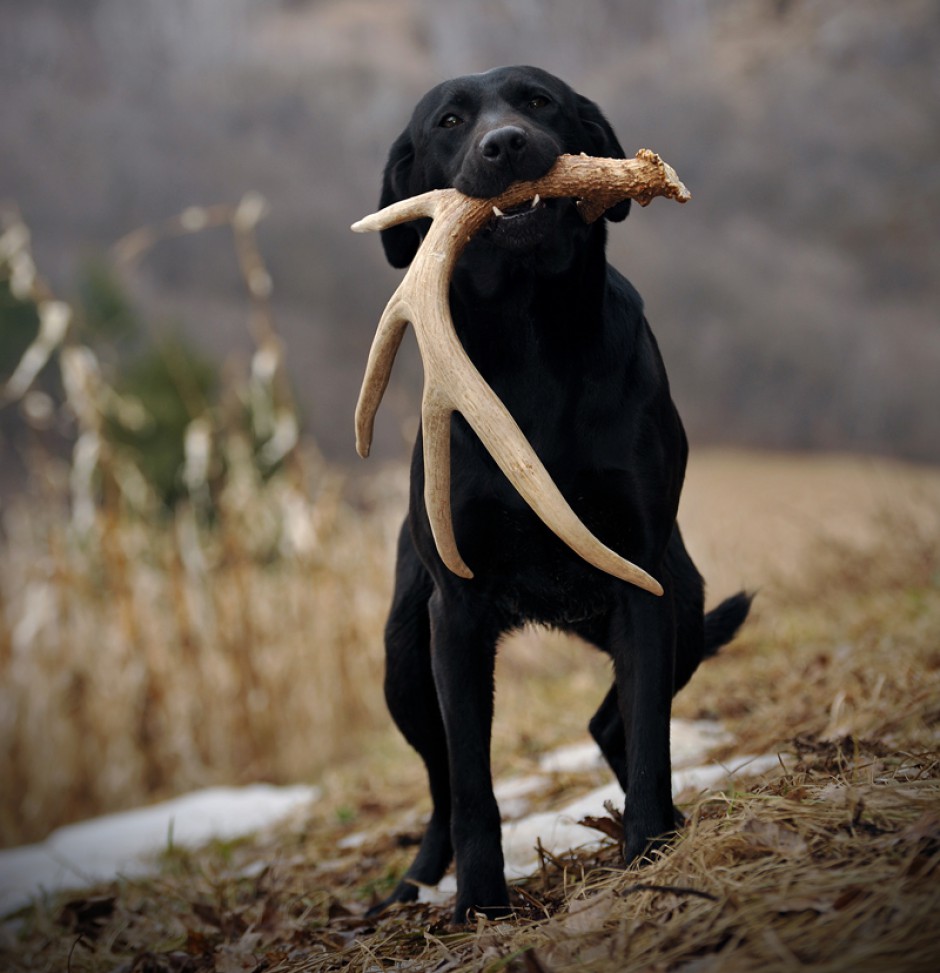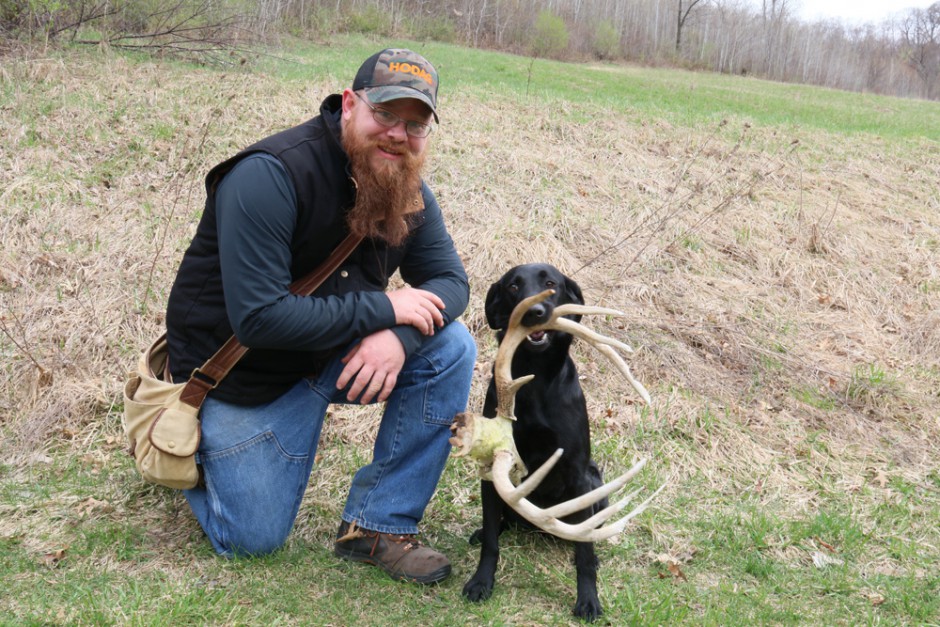Shed Dog Training Quick Tips:
1. Keep it simple!Shed dog training is not complicated and we should do everything in our power to keep it that way. The reality is that when it comes to training a dog to do something, whether it be shed hunting, retrieving birds or basic obedience, we are doing nothing more than forming habits. Habits are always formed through repetition and consistency. Another thing to keep in mind is that dogs are ALWAYS learning, so we as handlers have to be ALWAYS training. This certainly doesn’t mean you should be dedicating hours and hours each day to training, instead you need to figure out how to incorporate your dogs learning into your daily routine. When you do this, shed dog training takes NO extra time. This training can be working towards reinforcing positive or desirable habits, but should also include avoiding the bad ones. There is an old rule we follow closely that I learned a long time ago from our friends at Wildrose Kennels and that is “don’t train something into our dogs today that we will have to train out later”.
2. Condition the shape first and make sure it is positive.Although most shed dogs may use their noses equal to or more likely greater than their eyes, I always start out by introducing my dogs to the shape of an antler. I try to tap into their natural “predator/prey” instincts when it comes to making retrieves whether it an antler, a bird, or a tennis ball for that matter. The biggest thing to keep in mind is that for many dogs, retrieving will come pretty natural and the retrieve itself will be the greatest reward for them. This is where the idea of conditioning the antler shape comes in. Like I said earlier, many shed hunting dogs retrieve naturally and we as handlers have to make it understood to our dogs that certain objects will get them that reward.
A duck dog doesn’t retrieve a duck because they like ducks. I’ve listened to guys argue with me over this time and time again, “my dog is bird crazy, just loves birds more than anything!” The picture I paint for them is an ice-covered marsh with freezing temps and high winds (an uncomfortable situation to say the least). I ask them if their dog will retrieve a crippled duck that sails into the cattails across the pond. Always the answer is, “of course, and that is proof that my dog love birds”. My next question for them is, if I were to throw a stick over in the same place, would your dog retrieve it? Of course the answer is yes, but by this time, they get it and see where I’m going. The retrieve is what your dog loves, not necessarily the object they are retrieving. But certain objects are trained to equal that reward and the shed shape needs to be one of them.

3. What about the noses?A dog will rely on their nose as much as humans depend on their eyes; consequently you want to ensure that you train your dogs to use both their eyes and nose for locating sheds. For most dogs, using their noses to find things is very natural, so it’s simply conditioning what a shed smells like and connecting that to the reward (for most, the reward is the retrieve). So what does a shed antler smell like? The answer to this is pretty easy, yet totally complicated. An antler obviously smells, if you don’t believe me just put a few “fresh” sheds in a Tupperware tote with the lid on and keep it in the cab of your truck for a few hours on a sunny day. Take the lid off and grab a whiff, it will nearly knock you over. That is because the scent is concentrated.
So what actually smell on an antler? It will vary and no two are the same.
To list a few smells that are there always:
- Bone smells, all bone is calcium and will produce scent; fresh dropped sheds as well as old chalk sheds.
- Hair and blood. Fresh sheds often times have these caked into the pedicle area.
- Forehead gland scent. A whitetail deer has no less than 7 scent glands, which serve multiple purposes. The forehead gland is used when making rubs and for distributing scent to communicate with other deer. Make no mistake, this scent is found on shed antlers as well and serve as a scent clue for your dog.
- Speaking of forehead gland scent used when making rubs…have you ever seen evidence of a buck rubbing left caked into the antler? Of course you have, and don’t you think that has scent? A fresh rubbed cedar has a distinct scent, so is true with other varieties of tree species. As this rubbing debris deteriorates, the scent will continuously change. These are all scent clues to your shed dog. We train tracking or game recovery dogs to connect the scent created by a broken branch to act as a scent clue when trailing…same idea here with that scent found in a shed antler.
- Coyote scents. Coyotes are dogs. Dog’s benefit from calcium, hence all the antler chews sold in pet stores today. Coyotes will gather shed antlers in the wild and chew on them also. (take a close look at the tips of your sheds as they often times are chewed. It is very easy to see the difference between a rodent chew (mice, squirrels, porcupine’s etc) and a coyote’s chewing. When coyotes get to sheds first, and as soon as they do guess what? They have left their scent all over them. Another thing a male coyote will do much like his cousin the domestic dog is “mark” territory. I can’t tell you how often I have found yellow snow next to a shed in the woods. This is a major scent clue that our dogs will investigate. These are all scent clues for your dog if you prepare them accordingly.
- Rodent scents. We just talked about the impacts of those pesky chewers. The rodents all have scent and the moment they come into contact with a shed…you got it.
All of these scent clues and more are what are found on sheds, both fresh and old drops. And those scent clues are all important, but what might be more important than understanding what scents make up an antler is how your dog processes those scents. Dogs smell differently than we do, they smell in “layers”. What I mean is they have the ability to process tens of thousands of scents simultaneously, but individually, unlike the way a human smells.
Here’s an example. When I walk into the kitchen and my Mom is making vegetable soup, I smell vegetable soup. When my dog walks in, they smell salt, pepper, water, carrots, dirt that may have been left on the carrots, celery, peas, etc. See what I’m getting at, dogs don’t smell like we do so the sooner we understand that, the more effective we will be as trainers.

4. But what about MY scent on the antler?We just got into the impacts of scent and how it relates to our shed dog training in pretty good depth. Honestly, we didn’t even touch the tip of the iceberg. But I did want to address the concerns with your human scent. I can’t tell you how many people have been fooled into the fear of scent contamination when it comes to training a shed dog. I’ve heard all about the idea of specially designed washes or even boiling your antlers, rubber gloves, etc…
The issue I come across with the ideas of washing antlers to eliminate scents and then to handle them with rubber gloves is although I do think that washing them can minimize some scent, that process is not discriminate in what scent(s) it does or does not effect. When you start washing antlers to clean them of scent, you begin to rid them of the stuff that you want as well as the stuff you don’t. As far as rubber gloves go, my nose is nowhere near as sensitive as our dogs but even I can smell a rubber glove. (I can’t detect human odor)
If you are using a rubber glove you may be minimizing human odor to some degree, but you are simply substituting another un-natural odor to the shed during training? My point is that if a handler spends the amount of time worrying about attempting to eliminate all un-natural scent for training purposes, the reality is they will not have time to train. They will be preparing for scent elimination (and even that is questionable) and once the dog makes a find they would have to repeat the process completely due to inevitable contamination. I first heard about the idea of washing sheds, rubber glove, etc a few years ago from a gun dog trainer…my question has always been, do they go through that process when they train their gun dogs? I’ve never heard of anyone washing, spraying down or handling with rubber gloves all their ducks, pheasants, bumpers, tennis balls, etc each time they train? In my mind that doesn’t make sense and I assume those dog trainers feel the same way? What difference would there be when it comes to training a dog to hunt sheds?
Next steps.
So what’s next for you as a trainer? Remember that shed dog training doesn’t have to be complicated. Continue to encourage your dog to form and build good habits through daily repetition and consistency. From there, begin to work small, incremental training sessions into your day with our shed training system and you will be well on your way to having an excellent shed dog on your hands!












































